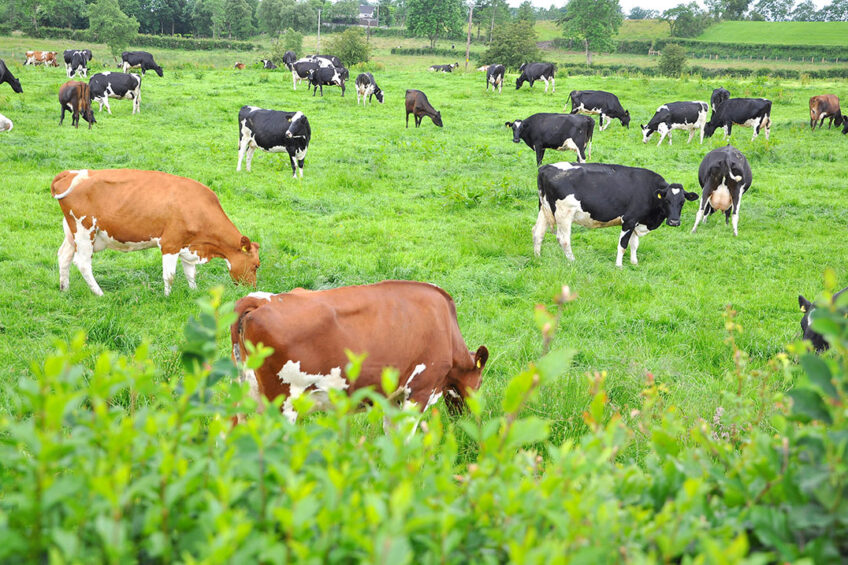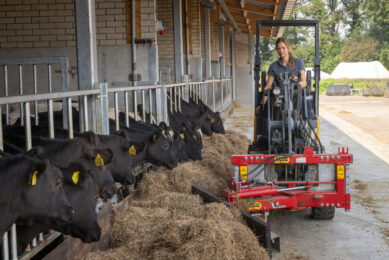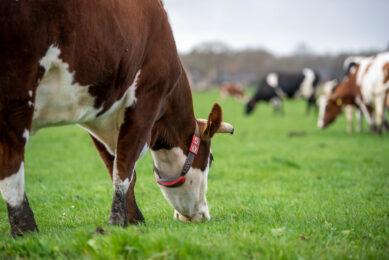Ensuring repeat grass growth is essential

Managing grasslands can be a complex task for dairy farmers and is mostly influenced by the country they are in and the climate there. Some farmers opt to keep cows out all year round and take advantage of the cow being able to feed herself and dispose of her own manure, reducing the overall costs of production.
Other farmers in hotter climates, or indeed wetter, choose to keep the herd indoors and haul fresh grass or alternatives to the livestock housing to feed them and then haul away the manure, which has higher costs. It could be argued that farmers who manage their herds using both these scenarios during a year are getting the benefits of both practices, but in the end it all comes down to grass availability and repeat growth.
However, today’s dairy farmer has a bit more to keep in mind when managing the grass growth programme on their farm, as they also have to consider carbon sequestration in the plans.
UK and Ireland grow good grass levels
Due to their moderate climates, the UK and Ireland are recognised as 2 of the major dairy-producing regions that can grow good grass levels. Based on this, a lot of research has been carried out there on the best practices farmers can adopt to ensure their farms are producing the grass required.
Across the northern hemisphere, farmers are already well into the 2021 grass growing season, but poor early growth rates have set some farms weeks behind due to the colder and wetter spring. This has also affected the silage season, with contractors reporting the first cuts were on average three weeks later than usual in some regions.
Research at Northern Ireland’s College of Agriculture, Food and Rural Enterprise (CAFRE) has looked at the various numbers farmers need to know to ensure grass production levels are optimum. Kathryn George is one of the dairy development advisers at CAFRE who has carried out a great deal of work on managing grasslands.
George says: “Managing grass is all about striking a balance between a number of key metrics – including grass growth, stock demand, average cover and rotation length – while maintaining cow production. Starting off with stock demand, we need to know the area that is available to graze as well as stock requirements.”
Taking an example herd of 120 cows with a total area of 30 ha available to graze gives a stocking rate of 4 cows/ha. If the cows are out day and night, a target intake of 16 kg grass dry matter (DM) is assumed with the remainder of the diet fed as concentrate in the parlour.

Grass supply and demand
Grass demand is a function of stocking rate multiplied by grass intake, so in this example 64 kg DM/ha/day (4 cows/ha x 16 kg DM/cow). Therefore grass needs to grow at 64 kg DM/ha each day to meet the herd’s requirements.
Then taking a closer look at grass supply, which needs to be measured as growth rate on a weekly basis. The most common tool for measuring grass is the rising plate meter, which measures compressed grass height and converts it to kg DM/ha through a calibrated equation.
Even though growth rates reflect what has happened in the past, it forms the basis of decision-making for the future. Actions to take will depend on what likely grass growth rates will be in the next week. The average farm cover is an indicator of the quantity of grass on the grazing area. In the main season this should be maintained at around 2,200 to 2,300 kg DM/ha.
Post-grazing residuals in well-managed swards should be around 1,600 kg DM/ha. Target pre-grazing cover is calculated by allocating the daily herd demand (120 cows x 16 kg DM = 1,920 kg DM) to the daily grazing area.
On a 20-day rotation this would be 1.5 ha (30 ha / 20 days) in this example, giving a herd demand of 1,280 kg DM/ha (1,920 kg DM/1.5 ha). Therefore, pre-grazing cover should be the post-grazing cover plus the herd demand which is 2,880 kg DM/ha in this example. The aim should then be to maintain an average cover during the mid-summer period of 2,240 kg in this example (2,880 +1,600 = 4,480/2 = 2,240 kg DM/ha).
Rotation length is the number of days it takes to complete one cycle of the grazing area. During the main grazing season this should be 20–24 days. The reason for targeting a 21-day rotation is due to the ryegrass plant maintaining three live leaves at one time. Under ideal conditions during the main growing season a new leaf emerges every 7 to 8 days with the ideal time to graze being between 2.5 and 3 leaves.
Summing all this information up, George adds that “managing grass is not an exact science. However, measuring grass growth and basing grazing decisions on this information helps to get the best out of it.”

Timely grazing and benefits
Well-managed, high-quality grass is beneficial to the animal, the sward, the environment and the farmer. Quite often, cows are turned into fields to graze grass that is not at the optimum stage for grazing, which is an important factor according to Teagasc dairy adviser Tom Murphy in the Republic of Ireland.
Murphy highlights that the challenge is to graze each sward when it is at, or the closest to, the correct stage for grazing in terms of the stocking rate of the farm and the time of year. “Grazing swards at higher than this can create a repetition of similar cycles, and the negative consequences are extrapolated,” he says. “Paddocks that are grazed too soon lead to a reduction in overall growth, as the sward becomes exhausted. In a typical 3-week cycle, 50% of the yield is grown in the third week. When grazed at the correct stage, paddocks are grazed off better, which leads to increase tillering, better regrowth, fewer weeds, more leaf material and less stem.
“Higher animal intakes, in turn, help in keeping the post-grazing height correct and consistent. When the grazing rotation is managed well, quicker regrowth results.
“Persistency in the sward improves and the output and response to fertilisers also jumps ahead. Shorter rotations with dense swards leads to more grazings per paddock. The higher growth rate and quality leads to an additional increase in grass utilised,” he adds.
Research has shown the benefit of this to be about 1.5 tonnes of grass DM for an extra grazing rotation, which is worth around € 175/ha to a dairy farmer.
Good grassland management benefits the environment, as when more optimum grass is produced it is utilised better and less methane is produced compared to cows eating high fibre grass. Grazing animals redistribute their own manure, leading to less slurry production and less ammonia gasses produced. Murphy says that grazing grass at the correct stage or cover, instead of allowing five or more extra days of growth, results in a 15% reduction of greenhouse gas production.
Carbon sequestration
Carbon sequestration is a natural or artificial process by which carbon dioxide is removed from the atmosphere and held in solid or liquid form. Grasslands can absorb carbon dioxide (CO2) during growth of grass plants and store it in different tissues.
When cows graze the grass, the carbon will eventually return to the soil as manure or to the atmosphere via enteric fermentation. The remaining grass and roots will eventually decompose and the carbon will then be stored in the soil. Farmers, therefore, can play a vital role in carbon sequestration by managing their grassland areas well to ensure they act as good stores of carbon.
Soil organic carbon (SOC) storage is of interest due to the role it can play in removing CO2 from the atmosphere. However, grazing practices that favour SOC have benefits for farmers apart from carbon sequestration. These benefits include increasing the quality of the soil, as soils with high carbon generally have better soil structure and water-holding capacity and provide more nutrients.
They also benefit farmers by reducing on-farm costs and adding value to the final product. Different attributes of the various grassland management techniques can increase carbon sequestration. For example, grazed pastures may sequester more carbon than grasslands used to produce silage or hay due to the recycling of organic matter and nutrients from faeces and plant residues.
Heifer grazing
Rearing dairy replacement heifers is a significant cost for all dairy farmers, but applying good grass management can help mitigate these costs. Getting heifers to the right weight and stature for 24-month calving requires an average weight gain of 0.8 kg/day throughout the rearing period. Achieving this performance at grass can be a challenge but is entirely possible with the correct feeding and management. Depending on the age, weight and rearing environment of a heifer, she will require a daily energy intake of approximately 70KJ in order to achieve a 0.8 kg daily liveweight gain.
Research at AHDB in England has found that using rotational grazing techniques on a heifer grazing platform not only helps train replacements for herd life, but also creates the quality leafy grass necessary for rumen development and daily liveweight gain.
The advice for farmers to gain the maximum growth benefit of these heifers at grass is to ensure the grass is of good quality, usually at the two-leaf stage, and to be strict about when to move the animals. In practice, heifers should be moved every two to three days to prevent back-grazing. Also, farmers should ensure autumn-born heifers are robust enough before turnout.
Although rotational grazing grows leafy, high-energy grass all year round, calves need a good start on colostrum, followed by rumen development of at least 6 weeks’ milk feeding before a gradual weaning over 10 days to avoid any growth checks.
It takes 3 weeks of eating concentrate, or leafy grazed grass, to grow enough bacteria for the rumen to function and produce useful energy for growth.
Join 13,000+ subscribers
Subscribe to our newsletter to stay updated about all the need-to-know content in the dairy sector, two times a week.










